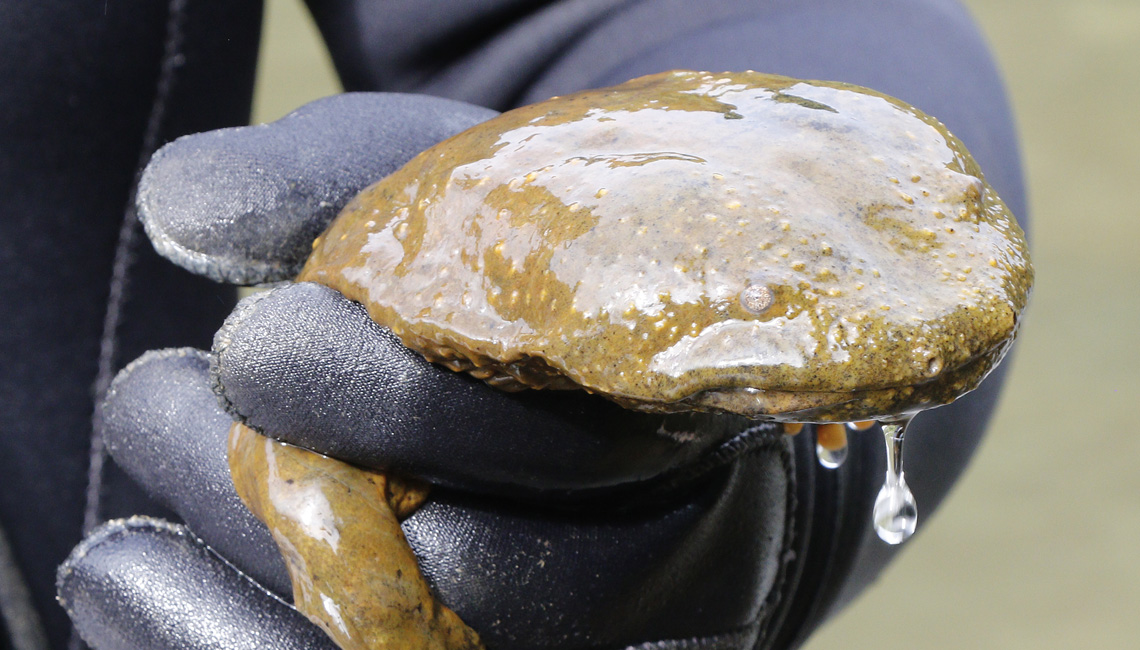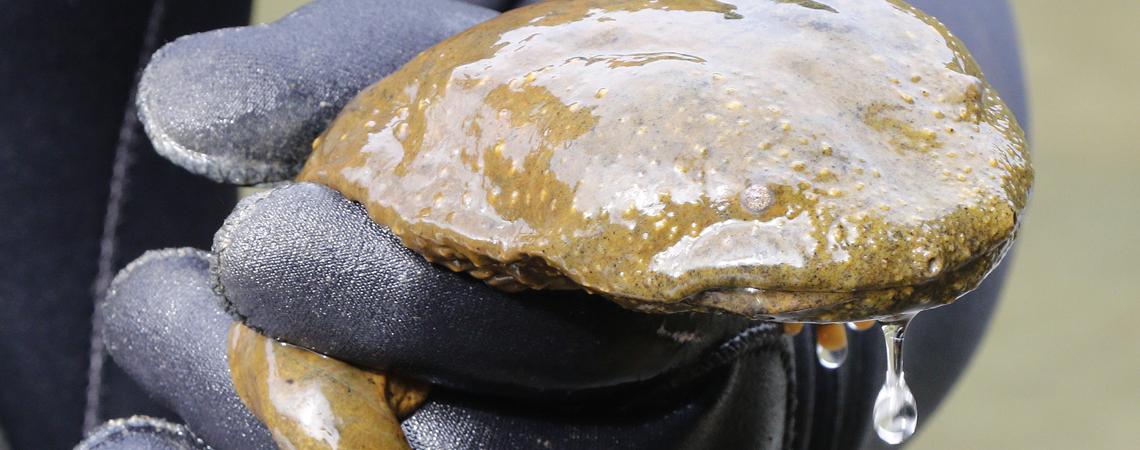Herpetologist Greg Lipps, standing knee-deep in the Kokosing River in Knox County, lifts the side of a large, flat rock and tilts it up on edge. As the swirling mud below slowly clears, he stares intently into the water. If the critter he’s searching for is lurking there, it won’t be hard to see.
Measuring up to 30 inches long and weighing more than 5 pounds, the giant aquatic salamander he seeks is also the largest amphibian in North America: the Eastern hellbender.
Measuring up to 30 inches long and weighing more than 5 pounds, the giant aquatic salamander he seeks is also the largest amphibian in North America: the Eastern hellbender.
No one seems to know for sure how or where the name “hellbender” came from. One theory claims that this docile, harmless salamander was named by early American settlers who thought it so ugly, “it was a creature from hell where it’s bent on returning.” Other common names for Cryptobranchus alleganiensis include devil dog, mud dog, water dog, and grampus. My personal favorite — for the disgusted reaction it triggers — is “snot otter,” describing the heavy coating of mucus that covers the creature’s wrinkled, mottled-brown skin.
On this occasion, however, no hellbender emerges. “Unfortunately, hellbenders are not doing well in Ohio,” Lipps says, sighing disappointedly as he carefully lowers the rock back into place. Lipps, a member of Malinta-based Tricounty Rural Electric Cooperative, is the amphibian and reptile conservation coordinator at Ohio State University, and he studies the creatures as part of his research.
“Hellbenders have lost about 80% of their habitat since the mid-1980s, when the first statewide survey was conducted,” he says. “The loss is mainly due to excessive siltation in many of Ohio’s streams because of human activity, which affects reproduction. As a result, the hellbender population is now made up mainly of adults. There are precious few young coming along to replenish that aging population.”
Today, these creatures are listed as state-endangered. Does that mean the eventual extirpation of hellbenders from Ohio? Wildlife biologists aren’t sure — possibly it’s too late already — but they’re not waiting to find out. Many wildlife conservation organizations in the state have banded together to form the Ohio Hellbender Partnership. Two of those partners, the Toledo and Columbus zoos, are helping by collecting hellbender eggs in the wild and rearing the young in biosecure facilities, where survivability can be much higher than in the wild. Some of the young hellbenders, measuring about a foot long, are later released in the same streams in which the eggs were collected, while others are used to repopulate streams that have supported hellbenders in the past. Since 2012, more than 1,600 young hellbenders have been released at 26 sites in 10 watersheds.
At the northern fringe of their North American range in Ohio, hellbenders inhabit a very specific aquatic habitat niche. Preferring clear, relatively fast-moving rivers in the unglaciated portion of the Buckeye State, they are only found in streams that drain into the Ohio River — not Lake Erie. Most are found along the bends of streams at the base of steep, heavily wooded hillsides and, as previously mentioned, under large, flat slab rocks.
So why should we care if a big, unattractive, slimy salamander that most of us will never see in the wild disappears from Ohio? As I’ve emphasized here before when discussing endangered species: If our natural environment ever becomes so uninhabitable that wildlife can’t survive, guess who’s next?
How to help
If you’d like to support Ohio’s continuing hellbender management and research projects, participating in any of the following four options provided by the Division of Wildlife will help:
- Purchase a wildlife conservation license plate
- Donate to the state tax checkoff program
- Purchase an Ohio Wildlife Legacy Stamp
- Or simply mail in a donation
Ohio hellbender partnership members
- Toledo Zoo
- Columbus Zoo and The Wilds
- Penta Career Center
- ODNR, divisions of Wildlife and Natural Areas and Preserves (Scenic Rivers Program)
- Ohio EPA
- U.S. Fish and Wildlife Service
- Ohio State University
- Ohio University
- Soil and Water Conservation districts in Jefferson, Belmont, and Columbiana counties
- Park districts in Columbiana, Knox, and Franklin counties
- Natural Resources Conservation Service
- Captina Conservancy










